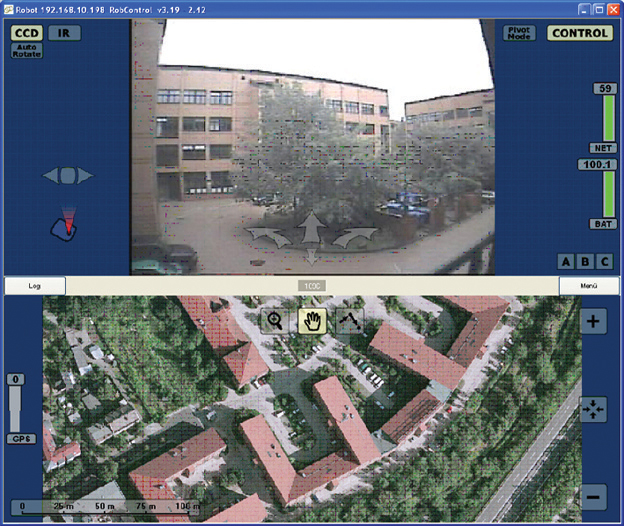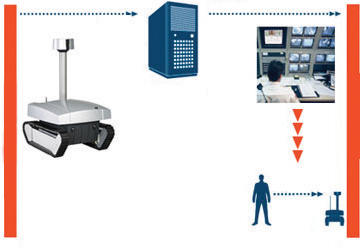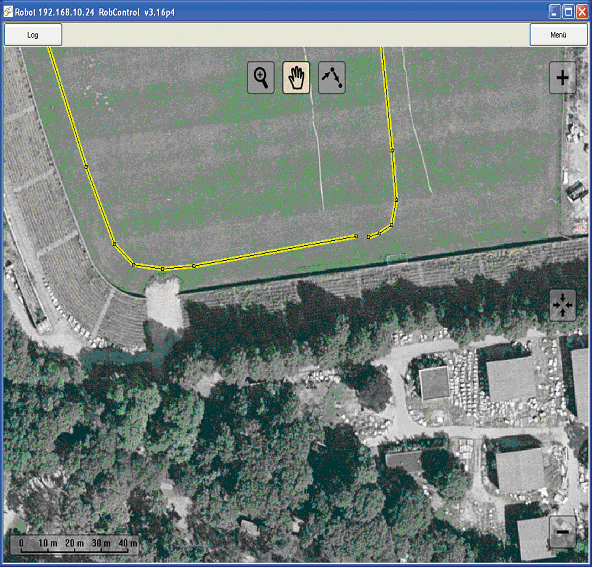By Ulf Stremmel

The OFRO terrain robot patrolled the outdoor areas and fencing of the Berlin Olympic Stadium. (Photo by Robowatch Technologies GmbH )
Since the September 11, 2001 attacks, the world has learnt a new, virtually universal, catchword: “Homeland Security”. This refers to measures for prevention of, intelligence-gathering on and responding to terrorist attacks, through which the survivability of the state is to be ensured. Terrorism, too, has itself evolved and attained a new dimension even in the years before these outrages. Alongside classical attacks with explosives, to an increasing extent nuclear, biological and chemical weapons are being used. This was made abundantly clear by the attack on the Tokyo subway system in 1995 by the AUM Sect. To protect the general public, new technologies must, therefore, be developed. This would include biometric systems, intelligent video analysis, detectors for all weapons types and conspicuous behavior, as well as novel screening devices and related inspections. There is also a marked trend to complement stationary technologies with mobile systems, like surveillance, reconnaissance and defusing robots.
COOPERATION AS A SIGN OF THE TIMES
The challenge of the future is to comprehensively protect a country’s citizens. For this reason, issues of preventing terrorist attacks and criminal acts as well as the protection of infrastructures and central services supply are given top priority in the internal and external political agendas of the international community of nations. Additionally, governments, commerce, industry, scientific institutions and civil authorities must act in concert to drive the development of terror prevention technologies. In this connection, apart from setting the political agenda, political institutions must also create the economic conditions that facilitate innovations in science and industry. Academia, in turn, must orientate its research more to achieving practical outcomes and, not least, the security industry is called on to develop comprehensive security concepts that take due account of preventative measures and new technologies. Concrete approaches already exist. Thus, many international research programs are addressing the problems of how major events, various infrastructures and commodity chains could be protected in the near future by technologies that up to now have seemed totally futuristic. It is planned that intelligent surveillance cameras, mobile robot systems and unmanned aerial vehicles will automatically recognize wanted terrorists, persons with conspicuous behavior patterns and the dynamics of crowds, and relay this information to security personnel.

Control interface of the OFRO terrain robot (Photo by Robowatch Technologies GmbH )
ENTER MOBILE ROBOTS
Whereas in the past concerns were focused solely on ensuring safety at public events, monitoring industrial facilities or security at airports and stations, today at the same time prevention of terror attacks must be ensured -- a task that concerns the state and the private sector equally. Whereas the state still guarantees internal security, infrastructure operators have the necessary detailed knowledge on the basis of which they can themselves implement concrete protective measures most effectively. For this purpose, though, systemwide safety concepts must be developed and new technologies integrated into these. One of the pioneers in this sector is the Berlin-based enterprise Robowatch Technologies. As a leading provider of Autonomous Unmanned Ground Vehicles, or AUGVs, this company offers the security industry, but also emergency response teams and the military, tangible products that give warning in a good time to persons in dangerous situations, guard high-risk zones or extensive properties, and optimize reconnaissance for disaster control and civil protection.
Optimized Early Harm Detection
Up to now, security concepts have been based essentially on stationary solutions like video cameras, motion or smoke detectors and, above all, security personnel. But for early detection of potential harm caused by technical faults or human error, or arising from terrorist and criminal actions, mobile surveillance robots offer valuable support. Depending on the needs, they can be equipped with additional sensors for early detection of leaks and fires, but also for identification of nuclear, biological and chemical warfare agents. Thus, the mobile robots, such as MOSRO and OFRO for building and extensive outdoor surveillance respectively, could immediately issue warnings to the responsible, authorities, and so cut costs. For if suddenly escaping toxic gases or vapours are detected too late, there is a threat to life and property damage amounting to millions, could quickly be caused. If a warning is issued of escaping toxic gases or liquids, the control center additionally has the possibility of obtaining a precise overview of the situation at the location concerned, and can then initiate targeted counter-measures.
Protecting Emergency Teams
Emergency teams made up of police, fire department, disaster control and civil protection personnel repeatedly expose themselves to serious risks during their missions to save lives. But this risk is reduced if the rescuers know exactly what they can expect in a terrain or in a particular situation. For this reason, Robowatch has developed a rugged reconnaissance and transportation vehicle that can perform its functions even without a driver. So “CHRYSOR” is capable of traversing pre-set routes completely autonomously even in the most difficult terrain. Alternatively, as is generally the case for Unmanned Ground Vehicles (UGVs), it can be controlled by radio link from a central control position. Thanks to 360° panoramic shots, a telescopic observation arm and the latest sensor technology, CHRYSOR rapidly and comprehensively scans its surroundings, and detects moving objects or hazardous substances. This allows mission control and emergency teams to assess the degree of hazard from a safe distance and take action as appropriate.
PROTECTING THE BERLIN OLYMPIC STADIUM
The fact that mobile, autonomously navigating robots are no longer just concepts for the future has been proven by numerous missions. Taking as an example security at the Berlin Olympic Stadium during the 2006 FIFA World Cup competition, it is demonstrated that they are an effective option, particularly if alongside classical safeguarding of property, protection of critical infrastructure also has to be ensured. And who does not doubt that a World Cup stadium is at high risk during the four weeks of the competition? The Soccer World Cup was the major event in 2006. Millions of football fans throughout the world followed the games and celebrated in stadiums, public viewing areas or in front of their TV screens at home. The organization and implementation of security measures were to be correspondingly complex. And this started long before the crowds gathered. Open areas had to be comprehensively safeguarded and buildings permanently monitored -- any negligence could have had serious consequences.
The human factor is always the weakest link in the security chain. In particularly sensitive areas, where a heavy stream of information has to be processed or monotonous tasks performed, human attention can quickly become overtaxed. For this reason, during the World Cup in the Berlin Stadium, apart from security personnel, were also deployed surveillance robots.

Figure 1. Patrol route and fixed orientation points (Source: Robowatch Technologies GmbH)

Figure 2. Information path for stadium surveillance (Source: Robowatch Technologies GmbH)
From VIP Rooms to the Mayfield -- All in View
A total of twenty robot systems patrolled during the night in and around the stadium. The MOSRO indoor robot was deployed for surveillance of circuit passageways, underground garages and storage areas. This meant that costly installation of stationary surveillance technology, like cameras and motion detectors, was no longer needed. The integrated smoke and heat detectors expanded the robots’ tasks to include fire watch. A further advantage: flexibility in personnel deployment scheduling -- as it is only the interaction of man and machine that permits continuous and therefore effective monitoring of inaccessible areas.
The OFRO terrain robot patrolled the outdoor areas and fencing of the Olympic Stadium, in particular the Mayfield sports area. So that this robot could actually undertake the patrol duty autonomously, during a preparatory phase, OFRO had to learn to find its way around several surveillance routes. For this purpose, the surveillance staff steered the robot via remote control around the complete patrolled route and saved the data with starting position and route information to a site plan, based on a satellite image of the Berlin Olympic Stadium. By way of its integrated GPS receiver, during its autonomous patrols OFRO compared the saved GPS points with its current position and automatically corrected for any deviations. Autonomous action was also required for detecting and driving around obstacles. Because the Mayfield is particularly busy due to delivery and pedestrian traffic, here the robot frequently encountered obstacles, like setdown containers or parked vehicles.
The robot recognized such obstacles thanks to its sonar and laser sensors, stopped briefly, reversed a little, and then drove to the left or right past the object.
Cameras
During its surveillance patrols, OFRO was continuously in contact with the control center, the “Skybox”. Here, via the robot’s CCD camera, the security personnel could view the surroundings in video quality. Additionally, the wide-angle lens used meant that objects lying on the ground appeared in the display as from a distance away of 1.3 m. Furthermore, OFRO possesses its own thermal imaging system, by means of which the security staff could remain in the picture during night time. Both camera systems -- CCD and thermal -- acted at the same time as motion sensors. Checking the pixel precision of video data for deviations meant that the robot could detect and signal back information on moving objects during its surveillance patrols.
Evaluation
The robot transmitted the camera images, but also noises and all sensory data, via rapid UMTS data links through the Vodafone mobile radio network to the Danger Management System (Siemens Building Technologies, SBT) in the Stadium Control Center. The shift supervisor at the monitor was, therefore, kept informed of the robot’s technical status, for example, battery charge and signals from all sensor elements, as well as its current position. Additionally, the management software on the PDA devices was available, which meant that security personnel were informed of all signals from the robot, irrespective of their location. In an emergency, it would have even been possible to navigate the robot from this control unit.
It is said that hindsight is always 20-20. However, those responsible for safety cannot wait that long. So, the security team at the Berlin Olympic Stadium took a new approach to ensure success during the Soccer World Cup. After just a short time, interaction between the experienced staff and their metal colleagues was extremely professional and with constant precision. The advantage: both parties could concentrate on those tasks which best matched their capabilities: the security personnel were deployed for safeguarding training sessions and games, and the tireless robots took over the monotonous night shifts. At the same time, they could have issued warnings of invisible hazards to the control center. This meant that safety in the stadium was guaranteed at all times, and at acceptable cost.
Dipl.-Ing. Ulf Stremmel is CEO of Robowatch Technologies GmbH (http://www.robowatch.de/).
For more information, please send your e-mails to swm@infothe.com.
ⓒ2007 www.SecurityWorldMag.com. All rights reserved. |



